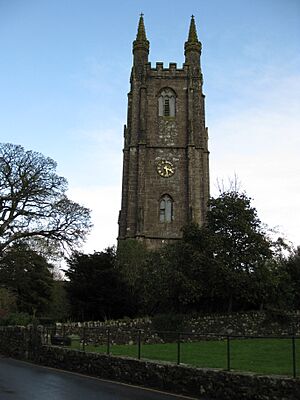Church of Saint Pancras, Widecombe-in-the-Moor facts for kids
The Church of Saint Pancras is a famous church in Widecombe-in-the-Moor, Devon, England. It belongs to the Church of England. People often call it the Cathedral of the Moor. This church is very old and important, so it has a special Grade I listing.
Contents
Why the "Cathedral of the Moor" Nickname?
This church got its special nickname because it is so big. It has a tall tower that stands 120 feet high. For a small village like Widecombe, the church is much larger than you might expect. It can hold many people inside.
How the Church Was Built
The church was first built in the 1300s. It was made in a style called Perpendicular. This was a late part of the Gothic style. Builders used strong granite stones found nearby. Over the next 200 years, the church became even bigger. This was partly thanks to money from the local tin-mining trade.
Inside the church, the ceiling has many cool decorations. These are called roof bosses. One special boss shows three hares in a circle. This is a symbol for tin miners and is known as the Tinners' Rabbits.
The Great Thunderstorm of 1638
The church was badly damaged in a huge storm in 1638. This event is known as the Great Thunderstorm. It seems the church was hit by a rare type of lightning called ball lightning. An afternoon church service was happening at the time. The building was full of about 300 people. Sadly, four people died, and around 60 were hurt.
Local stories say that the Great Thunderstorm happened because the Devil visited the village.
Long Walks to Church
For hundreds of years, the area around the church was very large. Families had to walk for miles to come to church every Sunday. It was even harder when they had to bury someone. Coffins had to be carried over rough land. They also had to go up and down very steep hills.
The Coffin Stone Legend
Halfway up Dartmeet Hill, there is a special rock called the Coffin Stone. It is close to the road. People would place the coffin on this stone to rest during the long journey. The rock is split into two pieces. A local legend says that a very bad man's body was once laid there. God was not happy about this. So, God struck the stone with a thunderbolt. This destroyed the coffin and split the stone in half.
People Connected to the Church
Beatrice Chase was a writer famous in the early 1900s. She wrote many novels about the Dartmoor area. She is buried in the churchyard of Saint Pancras.


